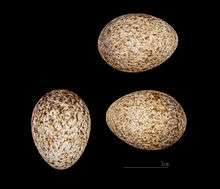Spectacled warbler
| Spectacled warbler | |
|---|---|
 | |
| Male on Gran Canaria | |
| Scientific classification | |
| Kingdom: | Animalia |
| Phylum: | Chordata |
| Class: | Aves |
| Order: | Passeriformes |
| Family: | Sylviidae |
| Genus: | Sylvia |
| Species: | S. conspicillata |
| Binomial name | |
| Sylvia conspicillata Temminck, 1820, Sardinia | |
- Not to be confused with the speckled warbler, an Australian bird in the Acanthizidae family.
The spectacled warbler (Sylvia conspicillata) is a species in the typical warbler genus Sylvia. The genus name is from Modern Latin silvia, a woodland sprite, related to silva, a wood. The specific conspicillata is from Latin conspicillum, a place to look from, equivalent to "spectacled".[2]
It breeds in north west Africa, southwest Europe from Iberia to Italy, and then further east on the eastern Mediterranean islands and coastal regions. It is mainly resident in Africa, but other populations migrate to winter in more widely in north and west Africa and Egypt. This bird is a rare vagrant to northern and western Europe.
It also occurs in some Atlantic islands. The subspecies orbitalis has been proposed for those of the Cape Verde Islands. The presumed subspecies for the Madeira birds, bella is today usually included in this taxon, as are the birds of the Canary Islands, where the species is quite common except on El Hierro and known as zarzalero y ratonero.[3]
These are very small "warblers" and are intermediate between whitethroats and Tristram's warbler in coloration. Spectacled warblers are brown above and buff below, with chestnut wing patches and a white throat. Adult males have a grey head and the white eye ring which gives the species its name. Immature birds can be confused with both the whitethroat and the subalpine warbler, and identification is difficult in the field. The song is a fast high warble.
About the precise relationships of this bird, not much can be said with certainty. It seems though as if its intermediate appearance, apart from the autapomorphic white eye ring, indicates its relationships reasonably well. It is not the closest living relative of at least Tristram's warbler though.[4][5]
These small passerine birds are found in dry open country with bushes. 3-6 eggs are laid in a nest in a bush. Like their relatives, the spectacled warbler is insectivorous.

References
- ↑ BirdLife International (2012). "Sylvia conspicillata". IUCN Red List of Threatened Species. Version 2013.2. International Union for Conservation of Nature. Retrieved 26 November 2013.
- ↑ Jobling, James A (2010). The Helm Dictionary of Scientific Bird Names. London: Christopher Helm. pp. 117, 376. ISBN 978-1-4081-2501-4.
- ↑ Álamo Tavío, Manuel (1975): "Aves de Fuerteventura en peligro de extinción". In: Asociación Canaria para Defensa de la Naturaleza (ed.): Aves y plantas de Fuerteventura en peligro de extinción: 10-32. Las Palmas de Gran Canaria.
- ↑ Helbig, A. J. (2001): Phylogeny and biogeography of the genus Sylvia. In: Shirihai, Hadoram: Sylvia warblers: 24-29. Princeton University Press, Princeton, N.J. ISBN 0-691-08833-0
- ↑ Jønsson, Knud A. and Fjeldså, Jon (2006): A phylogenetic supertree of oscine passerine birds (Aves: Passeri). Zool. Scripta 35(2): 149–186. doi:10.1111/j.1463-6409.2006.00221.x
Further reading
- Shirihai, Hadoram, Alan Harris and David Cottridge (1991) Identification of Spectacled Warbler British Birds 84(10):423-430
External links
![]() Media related to Spectacled warbler at Wikimedia Commons
Media related to Spectacled warbler at Wikimedia Commons
-
 Data related to Spectacled warbler at Wikispecies
Data related to Spectacled warbler at Wikispecies - Madeira Birds: Spectacled warbler
- Ageing and sexing (PDF; 4.5 MB) by Javier Blasco-Zumeta & Gerd-Michael Heinze
